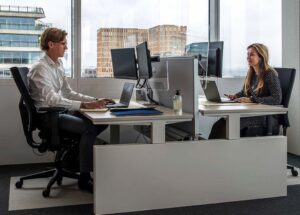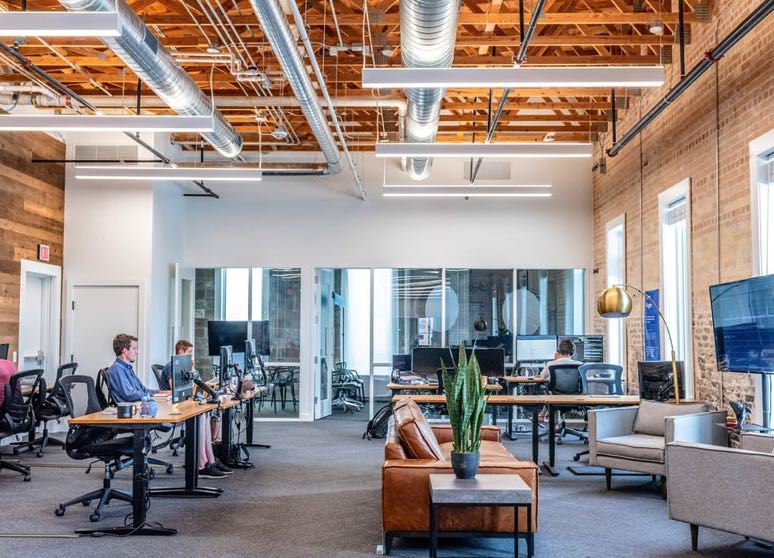by Elias Moses
With the Coronavirus’ fast out-spread, continued ‘work from home’ (WFH) options are challenging companies/organisations structurally and financially. This unprecedented thrust of change, affecting company’s day to day activity and productivity in work place, is hard to overcome in immediate future.
Most of the big companies are redrawing their work place options. To start with, as made official by IBM, 75,000 IBM India employees will permanently work from home soon, as IBM reduces office space by 50%.
Apart from safety measures employed, namely on dos and don’ts of workplace and hygiene methods such as hand spray and temperature detection, organisations have to completely redesign and restructure their work place for business continuity post Covid-19.
There will be no going back on it.
Work place Redesign
The last few weeks have resulted in a mass experiment in remote working world-wide. Work from home options are here to stay as a major part, and the numerous webinars that focus on equipping people to be productive as remote players are only a start.
 What will this lead to?
What will this lead to?
The biggest cause of concern is not so much the reduced number of people in the work place and the state of empty offices, since most operate from home, but the safety of those working from closed office-doors in close proximities.
Resolving this friction will require that office spaces undergo radical redesigning adjustments. The radical redesign should focus on physical operations and services provided.
To state some facts, at the global level, Facebook has unveiled a mixed reality workplace, which could help its employees work from home in the future, and real estate company Cushman & Wakefield has designed an office where worker scan keep six feet apart.
Some of the redesigned workplace options proposed are
- Augmented reality workstations
- Socially distanced office
- Closed plan work stations
- More signs as warnings on floor
- Contactless technologies in future
The coming age could witness a vast change in the way offices are specially designed and structured.
Workplace Restructure
The notion of putting 7000 people in a work place may be a thing of the past, as it is happening with IBM reducing its office space by 50%. Companies and organisations will have think in terms of having 25-30% of people to continue to work from home, meaning reduction of space.
Rightly so, Global workplace analytics predicts that upto 30% of people will have to continue to work from home for several weeks or months, post the pandemic.
 There was a time, not long ago, co-working space was offered as a dream option for social interaction. Today, on the contrary, architects have to restructure workplace or co-workplace plans that promote social distancing, due to the pandemic.
There was a time, not long ago, co-working space was offered as a dream option for social interaction. Today, on the contrary, architects have to restructure workplace or co-workplace plans that promote social distancing, due to the pandemic.
What an irony?
Given the gravity of the situation, some companies have already asked their architects for a radical rebuild or for a retrofit.
“I think we’ll see wider corridors and doorways, more partitions between departments, and a lot more staircases,” says Kaicker, who now heads analytics and insights at Zaha Hadid Architects.
He continues “Furniture may change too. Office desks have shrunk over the years, from 1.8m to 1.6m to now 1.4m and less, but I think we’ll see a reversal of that, as people won’t want to sit so close together.”
Soon, in my opinion, legislation might be introduced to mandate a minimum area per person in offices, as well as a reduction in maximum occupancy for lifts and larger lobbies to minimise overcrowding
And that high rise buildings may be less efficient and may reduce the economic attractiveness of developers in the future.
Workplace Re-costing
With the new challenges of health, hygiene and productivity as prime priority, companies are expected to consider decentralising their operations, that there is business continuity, even if one facility goes into containment.
Many companies, especially the IT enabled services that used to allot 70-80 sq.ft per person are expected to allocate more space to a standard 125 sq.ft. this is going to hit the space utilisation cost on the longer run.
Given the current cash-crunch situation, the current/existing office spaces cannot be expanded. Efficient planning and designing and restructuring are being worked out by companies. This will alter the cost factor allotted for space use.
With the business volume coming down drastically the first of quarter of FY 2020-21, Resizing team structure based on business requirement is the key for most companies. Many companies are already into it.
However companies cannot do away with workplace costing, as a physical workplace is a must for running business.
This will be a testing time for facility management departments of most companies, as they have reduce the space and renegotiate the rental rates on yearly basis.
From what I see, many companies have already started using the following options
- 1/3 work from home
- Reduction of space by 25%

- 10% buffer space for once a week visit
- Catagorization of office use-space
- ‘Skip the seat’ option
- Negotiate for more space at same rate
- 11 month Rental period as against 12 months
- Flexible work station set-up
The above mentioned options serve two main purposes namely curtailing the spread of virus and reducing the cost. This is going to help in the short run.
What about on the long run?
On the long run, companies will have to redesign and restructure their office spaces, and work out costs to fit the redesign and restructure.
Work from home is an option, but no company wants that as a ‘work culture’ going forward.
This will lead to the Redesign and Restructure of office space.
The following could be considered
- Main office space – for intentional and connected and corporate activity only
- Co-working space – increase in decentralised work place for health and productivity. It reduces travel time.
- Smaller space with ‘hot desking’ options – for multi purpose and task purpose only
- Restructuring leases and secure feature with flexibility norms – as pushed by clients
- Flexible work station set up a norm for future
With the resulting turbulence and uncertainty to last the entire FY 2020-21, organisations would be required to strategically align themselves with the need of the hour, avoid workplace redundancy, and take conscious decisions on restructuring and redesigning their workplace and its utility for optimum productivity.
Elias Moses is a Senior Business Strategist, Consultant, Researcher, Corporate and Leadership Trainer, Orator, Columnist and an Entrepreneur. He is also the Founder and Managing Director of a growing reality firm in south India. He is also the founder of Managing Next, an Online portal for knowledge share and consulting.
The author can be contacted@
email: elias@managingnext.in, linkedin: www.linkedin.com/in/eliasmoses
